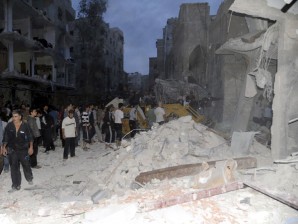
In this image released by the Syrian official news agency SANA , a crowd gather beneath the shattered facade of a building damaged by a car bomb in Damasus, Syria Friday Oct 26 2012. The blast in a residential area of Damascus, near a housing complex for police, killed five people and wounded more than 30, state TV said. A shaky holiday truce was marred by sporadic fighting and two car bombs Friday but gave war-battered Syrians a brief respite, allowing thousands of protesters to pour out of mosques to demand President Bashar Assad’s ouster. AP
BEIRUT — More than 36,000 people have been killed since the outbreak of Syria’s anti-regime revolt in March 2011, with an average of 165 people killed a day since August 1, a watchdog said Wednesday.
Civilians, at 25,667, represented the vast majority of those killed, said the Syrian Observatory for Human Rights, which includes non-military people who have taken up arms against President Bashar al-Assad’s regime in the category.
The rest were from the military — 9,044 government soldiers and 1,296 who defected to join the rebellion.
“In addition, we have documented the deaths of 439 other people whose identities we were unable to verify,” Observatory director Rami Abdel Rahman told Agence Franxe-Presse.
The Observatory does not include thousands of people who have gone missing in the conflict, some thought to be in detention and others dead. It also excludes thousands of pro-regime militiamen.
August was the deadliest month of the uprising with 5,440 killed, although the bloodshed has remained at a high lever since, with 4,985 victims in September and 4,727 in October.
The 15,152 people killed in the past three months averages out to 165 people killed a day.
On some days, heavy fighting on multiple fronts and nationwide shelling attacks caused sharp spikes in the death toll.
The bloodiest single day since the 19-month conflict began was on September 26, when 305 people were killed.
The Observatory relies on a network of activists, lawyers and medics at military and civilian hospitals inside Syria for its information.
The uprising began as pro-reform protests inspired by the Arab Spring but transformed into an armed insurgency after the government began brutally crushing demonstrations.
Most rebels, like the population, are Sunni Muslims in a country dominated by a minority regime of Alawites, an offshoot of Shiite Islam.